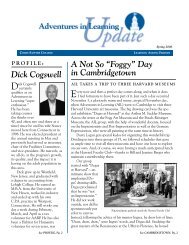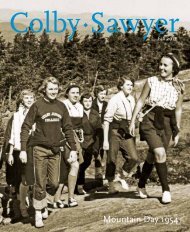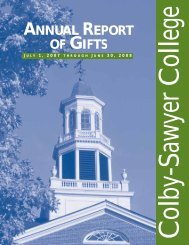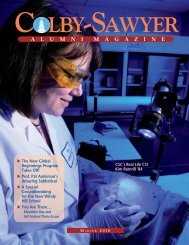A L U M N I M A G A Z I N E - Colby-Sawyer College
A L U M N I M A G A Z I N E - Colby-Sawyer College
A L U M N I M A G A Z I N E - Colby-Sawyer College
Create successful ePaper yourself
Turn your PDF publications into a flip-book with our unique Google optimized e-Paper software.
Thousands of Little Moments<br />
Finding Passion and Purpose in Africa<br />
I<br />
have been interested in Africa my whole life, and though I<br />
am not sure how this interest started, I know what fueled<br />
it. Throughout my childhood, the documentaries and<br />
television programs about Africa I watched made me want to<br />
experience the contrasting landscapes and incredible wildlife of<br />
the continent for myself. I never let go of that dream.<br />
My first year at college was a very uncertain period as I struggled<br />
to determine what my time at <strong>Colby</strong>-<strong>Sawyer</strong> should look<br />
like. Then the tug I felt about going to Africa deepened when<br />
my Pathway, Migration, discussed the origins of mankind and<br />
the possibility of the first early hominids having come from<br />
Olduvai Gorge in Tanzania. I cannot help but think of Africa as<br />
the raw birthplace of the earth and my own species. My classes<br />
“East Africa was the best and<br />
hardest teacher I have ever had.”<br />
at <strong>Colby</strong>-<strong>Sawyer</strong> encouraged my mind to “take off its Western<br />
thinking cap,” as Associate Professor of Natural Sciences Nick<br />
Baer says, and practice a global perspective.<br />
The School for Field Studies (SFS) is an organization with<br />
field stations all over the world for environmental, biology and<br />
public health study abroad programs. I was fortunate that the<br />
<strong>Colby</strong>-<strong>Sawyer</strong> Environmental Department has a partnership<br />
with SFS which enables seniors to study abroad during/in their<br />
fall semester, gain academic credits required for graduation, and<br />
have their directed research project (the most important aspect<br />
of the SFS program) become their senior Capstone. With the aid<br />
of my professors, I completed the application to spend Fall 2010<br />
in Tanzania and Kenya.<br />
I usually refer to my semester abroad as a dream come true.<br />
I wish I could properly describe the moment I was able to see<br />
the Olduvai Gorge, which I’d discussed in my Pathway class on<br />
campus, while traveling to Serengeti National Park on expedition<br />
in Tanzania, but that seems to be the overall nature of<br />
sharing my experience abroad: it’s a struggle to find words that<br />
might not even exist for the purpose I need. In the months<br />
since I returned, I have realized that my time in East Africa<br />
colored my life in more ways than I could have ever imagined.<br />
I never expected to leave a continent with two countries permanently<br />
printed on my heart, affecting every thought and<br />
action I have.<br />
28 COLBY-SAWYER ALUMNI MAGAZINE<br />
Story and photos by Jeanne Clark ’11<br />
The SFS program I attended begins in one country, where<br />
the students take classes and learn about the area, and halfway<br />
through the semester switches to the second country, where<br />
students conduct their final directed research projects. All the<br />
professors and staff at each site (Moyo Hill in Rhotia, Tanzania<br />
and Kilimanjaro Bush Camp in Kimana, Kenya) are from the<br />
area, except for the Student Affairs Managers—the “Mom”<br />
of each site—who were also Americans. I began my semester<br />
in Tanzania, studying wildlife ecology, wildlife management,<br />
environmental policy and introductory Swahili with 27 other<br />
American students.<br />
My group had the honor of being the first students at Moyo<br />
Hill, , as the site had just j been built over the summer.<br />
Sept. 5, 2010<br />
We arrived at our Tanzanian camp site on Tuesday,<br />
and as our Land Cruisers pulled past the gates (which<br />
had beautiful elephants and lions painted on them by a<br />
local artist), we were met by everyone who works here:<br />
all the staff, cooks and professors were there to cheer and<br />
welcome us with huge smiles.<br />
It was overwhelming to walk down this massive line of<br />
people, shake their hands, try to understand their Swahili,<br />
and attempt to remember so many new names. I couldn’t<br />
believe how happy they were to see us.<br />
They built this new camp site in the past three months<br />
and it is beautiful. At the original site, we would have been<br />
living in tents with little or no access to a private bathroom.<br />
Here, everyone lives in a little cement banda with<br />
three or four roommates and has their own bathroom.<br />
Our chumba (a bigger structure for large groups of<br />
people) is in the middle of the camp, where we study and<br />
have all our meals and big meetings. We have one classroom,<br />
a small library and computer room and the staff<br />
has their own offices and bandas. The camp is surrounded<br />
by a fence of thorny bushes—believe me, you don’t want<br />
to be caught in them.









